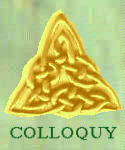Disclaimer: These tables summarize the present evaluations of scores for Colloquy, based upon the best data available to us as well as reasonable extrapolations from (a) authoritative tables of percentiles 50, 75, 90, 95; (b) widely accepted mean and sd values; (c) attempts to model normal population projections from undergraduate or graduate level test populations. In short, these values are estimates, subject to much debate and occasional revision. It should be emphasized that score analysis based on these means and SDs appears to be adequate for scores in the highest sixteen percent of the general population, but the relation between test raw scores and true (population) z-scores will not necessarily remain linear over a large span of percentiles. Our intent is simply to provide reasonable estimates as a basis of comparison, with full knowledge that while tests of mental ability are reaching for a common g-factor, they in fact present a spectrum of content and method of administration. Individuals are not without a certain range of fluctuation in performance too, so it's advisable to view test results and evaluation with a balanced perspective. As to the choice to accept academic tests for the purposes of Colloquy admission, it can be defended by (1) substantial correlation of such tests with standardized IQ, (2) population in the millions which has taken these tests under controlled conditions, (3) the fact that tests of this nature aim at assessment of academic aptitude, logic, comprehension, problem-solving, etc. Perhaps these are in some ways more germane to assembling a "parliament of minds" than many IQ tests per se. There are valid reasons for test publishers to de-emphasize any direct pairing between IQ and measures of academic aptitude. This is taken on advisement and finally may it be said that nothing presented here is intended to "step on the toes" of professionals in the field or psychometric officers of other societies.
Notes:
*(1) These values are for the original National Merit Scholarship Qualifying Test used in the '60s and early '70s. The NMSQT as a separate test was later discontinued in favor of a selection score *(1a) derived from a summation of PSAT scaled scores, the verbal score receiving double weighting. By 1995, a writing sample was incorporated, and the National Merit selection index *(1b) has thereafter been derived as the sum of writing sample, verbal, and math scaled scores.
*(2) Only the 40-minute timed version designated as Raven Advanced Progressive Matrices set II is acceptable for Colloquy. International Mensa's score reports generally do not list the raw score, but we can accept a minimum of IQ 160 on such a report. Age at testing date is an important concern with the Raven ... significant decline in raw scores has been observed for ages above fifty. Another form of the Raven test is administered in a supervised "liberally timed" version, as the Standard Progressive Matrices. The 1993 Des Moines standardization indicates that the ceiling of this S.P.M. is probably not above the 99.5 percentile.
*(3) California Test of Mental Maturity, to the best of our knowledge, is equivalent to the American Mensa Admission Test on the Mensa score reports of recent years.
*(4) composites of verbal plus math section scaled scores on the Scholastic Aptitude Test ... Beginning April, 1995, the general test has been designated SAT-I and scores have been reported on a recentered scale which returns both subtest means to the vicinity of 500. It's no surprise that the college-bound population of 1995 differs significantly from that of 1941. Use of the composite mean and standard deviation here is adequate for scores up to 99.5 percentile. For scores above that level, it seems better to use the paired original/recentered composites provided at College Board Online.Our tables for IQ scores 140=159 rely more heavily upon those.
*(5) composites of quantitative plus analytical section scaled scores ... these offer a fairer evaluation for non-native speakers of English and those whose strongest abilities may manifest in logic and mathematics. It wouldn't do to exclude a potential Feynman!
*(6) GRE general test scores above 800 were issued during the 1970's, though I've only seen them on the quantitative section. After the introduction of the Analytical test, 800 again became the maximum reportable score. A score at or near the test ceiling is best considered indeterminate.
*(7) The Miller Analogies Test is, by content, the ideal selection instrument for any group of the nature of Colloquy ... the high scorer is doubtless the possessor of a finely-cultivated knowledge base as well as formidable skills in logical thinking. Seven forms are administered and the tables have been updated accordingly to reflect the different values for each. The previous listing was appropriate for form V only. Composite data across all forms would be most similar to the values listed for form M. Recent score reports identify the form by a numeric code instead of the letter.

